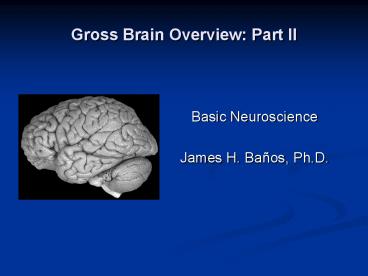Gross Brain Overview: Part II - PowerPoint PPT Presentation
1 / 66
Title:
Gross Brain Overview: Part II
Description:
Gross Brain Overview: Part II Basic Neuroscience James H. Ba os, Ph.D. Overview Organization Morphology Developmental/Evolutionary Cytoarchitectural 3-D Orientation ... – PowerPoint PPT presentation
Number of Views:108
Avg rating:3.0/5.0
Title: Gross Brain Overview: Part II
1
Gross Brain Overview Part II
- Basic Neuroscience
- James H. Baños, Ph.D.
2
Overview
- Organization
- Morphology
- Developmental/Evolutionary
- Cytoarchitectural
- 3-D Orientation to Internal Structures
3
- How do we organize and characterize different
parts of the brain?
4
- How do we organize and characterize different
parts of the brain? - Morphology
- Developmental/Evolutionary Origins
- Cytoarchitecture
- Function
5
Morphology External Features
6
Frog
Rat
Whats changing?
Cat
Monkey
Human
7
- Sulci - The valleys on the surface of the brain
- Gyri - The Hills
8
The term gyrus is sometimes used broadly and
doesnt always refer to a single well-defined
ridge on the surface of the brain. The
distinctions between large gyri are sometimes
better seen in coronal sections.
9
Hemispheres
Longitudinal Fissure
10
Lobes
Central (Rolandic) Sulcus
Lateral (Sylvian) fissure
Parieto-occipital fissure
11
Lobes
Cingulate Gyrus Limbic Lobe
12
Brain Stem
Thalamus
Hypothalamus
Midbrain
Pons
Medulla
13
Cerebellum Superior Aspect
- 2 Hemispheres
- Vermis
Ant
14
Cerebellum Posterior Aspect
Anterior Lobe
Primary Fissure
Posterior Lobe
15
Cerebellum Mid-Saggital
Anterior Vermis
Posterior Vermis
16
Developmental and Evolutionary Origins The
Cephalons
17
Developmental Origins
- Areas of the Brain can be characterized by the
embryonic origins of the tissue. - Nervous system begins as a tube that
differentiates into three vessicles - Prosencephalon
- Mesencephalon
- Rhombencephalon
Three Vessicle Stage
18
Developmental Origins
- Prosencephalon differentiates
- Telencephalon -- beginnings of hemispheres
- Diencephalon
- Rhombencehphalon differentiates
- Metencephalon
- Meyelencephalon
- We use this terminology to describe the parts of
the brain that develop from these vessicles
Five Vessicle Stage
19
Developmental Origins
20
Organization
- Telencephalon
- Cortex
- Basal Ganglia
- Limbic System
- Hippocampus
21
Organization
- Diencephalon
- Thalamus
- Hypothalamus
22
Organization
- Mesencephalon
- Midbrain
23
Organization
- Metencephalon
- Cerebellum
- Pons
24
Organization
- Myelencephalon
- Medulla
25
Cytoarchitectural Organization
26
Brodmanns Areas
27
Internal Structure
28
Major Internal Structures
- Ventricular System
- Amygdala (helpful landmark)
- Thalamus/Hypothalamus/brain stem
- Basal Ganglia
- Caudate Nucleus
- Putamen
- Globus Pallidus
- Hippocampal formation
- Hippocampus
- Fimbria
- Fornix
- Major white matter landmarks
- Corpus callosum
- Internal capsule
29
Evolution and Development
Frog
Rat
Cat
Monkey
Human
30
Evolution and Development
Frog
Rat
Cat
Monkey
Human
?
31
Evolution and Development
Ventricles
Basal Ganglia
Hippocampus
32
Evolution and Development
Why not the thalamus?
33
The Ventricular System
34
Ventricles
Lateral Ventricles
Third Ventricle
Fourth Ventricle
35
Ventricles
- Ventricles are connected (communicate)
- Intraventricular Foramina (of Monroe)
- Lateral Ventricles to Third Ventricle
- Wide, oval hole
- Cerebral Aqueduct (of Sylvius)
- Third Ventricle to Fourth
- Long, thin channel
- Foramen of Magendie
- Median aperture -- Fourth ventricle to
subarachnoid space - Foramina of Luschka
- Lateral apertures -- Fourth ventricle to
subarachnoid space
36
Ventricles
Foramen of Monroe
Aqueduct of Sylvius
Foramina of Luschka
Foramen of Magendie
37
Ventricles
38
Ventricles
39
Ventricles
40
Ventricles
41
Choroid Plexus and CSF
- Choroid Plexus
- Spongy tissue located in the ventricles
- Rich capillary bed
- Pia Mater
- Choroid endothelial cells
- Produces CSF
- About .35 ml per minute
- Total volume 70-120 ml
42
Choroid Plexus
43
CSF Flow
- Lateral ventricles
- Foramina of Monroe
- 3rd ventricle
- Aqueduct of Sylvius
- 4th Ventricle
- Foramen of Magendie/foramina of Lushka
- Subarachnoid Space
- Arachnoid granulations (absorption)
- Superior sagittal sinus
44
CSF Flow
45
CSF Absorption
- CSF flows to the dorsal surface of the brain,
where arachnoid granulations form a one-way valve
and let the excess CSF enter the veinous drainage
of the superior sagittal sinus
46
CSF Absorption
47
Arachnoid Granulations
48
Ventricular System plus Amygdala
49
Ventricular System plus Thalamus
50
Ventricular System plus Thalamus
51
Ventricles, Brainstem, and Thalamus
52
Ventricles, Brainstem, and Thalamus
53
Basal Ganglia -- Caudate Nucleus
- Basal Ganglia
- Caudate Nucleus
- Putamen
- Globus Pallidus
- Sometimes Amygdala
54
Basal Ganglia -- Caudate Nucleus
55
Basal Ganglia -- Caudate Nucleus
56
Basal Ganglia -- Caudate Nucleus
57
Basal Ganglia -- Putamen Globus Pallidus
58
Basal Ganglia -- Putamen Globus Pallidus
59
Basal Ganglia
60
Basal Ganglia
61
Basal Ganglia
62
Internal Capsule
63
Hippocampus
- Hippocampal formation
- Fimbria
- Fornix
- Anterior Commissure
- Amygdala
64
Hippocampus
65
Hippocampus
66
Coming up
- Spinal cord
- Basic Spinal Pathways































